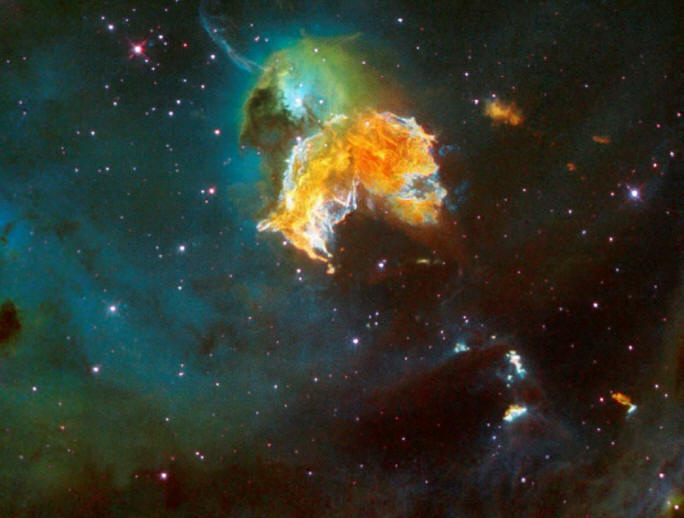|
|
Double Layer Detonation
Aug 20, 2009
Rather than thermonuclear
explosions, supernovae are what
Hannes Alfvén called them: exploding
double layers.
The
Large Magellanic Cloud (LMC) is
a relatively small, irregular galaxy
approximately 168,000 light-years
from Earth. The distance is
approximate, because different
parallax values are obtained
when different measuring sticks are
used.
Within the LMC is an object commonly
referred to as a "supernova
remnant," since the prevailing
theories of stellar evolution
prescribe a particular kind of death
when stars are extremely massive.
They are short-lived, as consensus
opinions state, converting their
mass into radiant energy at a
furious rate, through a process of
nuclear fusion. Once their nuclear
fuel is exhausted, a process begins
that ends with the star imploding
and blowing off its outer shell of
gas and dust.
The exploding star that created the
N 63A remnant is thought to have
been 50 times more massive than the
Sun.
So-called stellar winds from the
giant star generated a "wind-blown
bubble," according to a report from
the Hubble Space Telescope
news release archive. The
supernova is said to have exploded
inside the bubble, leaving a clear
region that contains small clouds of
cast-off material that the winds
could not blow away—similar to
smokey swirls inside a soap bubble.
It has been a
long-standing tenet of astrophysical
theories that supernova shock waves
are responsible for the formation of
other stars when they meet clouds of
gas in nearby nebulae. The gases are
compressed along the expanding
wavefront, acquiring the angular
momentum and gravitational boost
needed to begin condensing.
According to the Nebular Hypothesis,
once that condensation reaches a
critical point, stars are born.
However, an analysis by the Hubble
team concluded that the shock wave
generated by N 63A is moving too
rapidly through the expanding gas
clouds, impacting the "cloudlets"
and tearing them apart. They are not
destined to last long.
There is hope in the future, though.
Star formation is supposed to be
occurring in the LMC at 10-15
light-years from N 63A. NASA
contends that, a few million years
from now, the ejected stellar gases
flowing with the shock wave will
arrive at the star forming region
with reduced energy, initiating
areas of nebular collapse, and
creating new stars and planets.
Astronomers have no idea why stars
eject clouds of gas and dust that
eventually become other stars. The
primary reason for the conundrum is
that stars are made of plasma, not
gas and dust. A star is the focal
point for Birkeland currents that
flow along circuits through the
galaxy.
An electromagnetic z-pinch can
squeeze plasma with such force that
it rapidly compresses into a star,
forming a toroidal current around
the equator. Current density flowing
into the z-pinch causes the plasma
in the new star to erupt in an
arc-mode discharge.
The Electric Universe explanation is
that we are looking at plasma
structures when we look at nebulae
or supernovae, and they behave
according to the laws of electric
discharges and circuits.
Instead of mechanical action and
imploding gas, N 63A was created
when an influx of electric current
exceeded a critical value and was
unable to maintain a stable
connection with the galactic
circuit. The break in the circuit
caused the star to short-out and
explode, just like an electric
circuit here on Earth can suddenly
explode when too much current flows
through it.
As we have written in many Picture
of the Day articles, we do not live
in a mechanistic universe where
things happen only when there are
explosions, shock waves, compressed
gas, rebound, expansion or other
kinetic and gravity-based forces.
Rather, the universe is a seething
cauldron of electrical energies that
exceed the powers of gravity and
inertia by several orders of
magnitude.
It is electric
currents in plasma that makes up
what we observe. Rather than an
expanding shock-front, the features
shown in the Hubble image are lit by
electricity passing through dusty
plasma. The x-ray radiation is
typical of that given off by ions
accelerated by an electric
discharge.
Written by Stephen
Smith from an idea submitted by Eric
Aitchison
|
|
|
|
|
|
SPECIAL NOTE - **New Volumes Available:
We are pleased to announce a new
e-book series
THE UNIVERSE ELECTRIC. Available now, the first volume
of this series, titled Big Bang, summarizes the failure of modern cosmology
and offers a new electrical perspective on the cosmos. At
over 200 pages, and
designed for broadest public appeal, it combines spectacular
full-color graphics with lean and readily understandable
text.
**Then second and third volumes in the series are now available,
respectively titled Sun and Comet, they offer
the reader easy to understand explanations of how and why these bodies
exist within an Electric Universe.
High school and college students--and teachers in
numerous fields--will love these books. So will a large
audience of general readers.
Visitors to the Thunderbolts.info site have often
wondered whether they could fully appreciate the Electric
Universe without further formal education. The answer is
given by these exquisitely designed books. Readers from
virtually all backgrounds and education levels will find them
easy to comprehend, from start to finish.
For the Thunderbolts Project, this series is a milestone.
Please see for yourself by checking out the new
Thunderbolts Project website, our leading edge in
reaching new markets globally.
Please visit our
Forum
|
|
|
|
|
|
|
|







